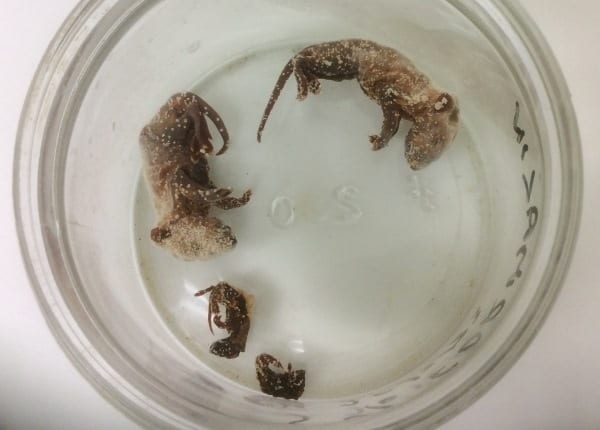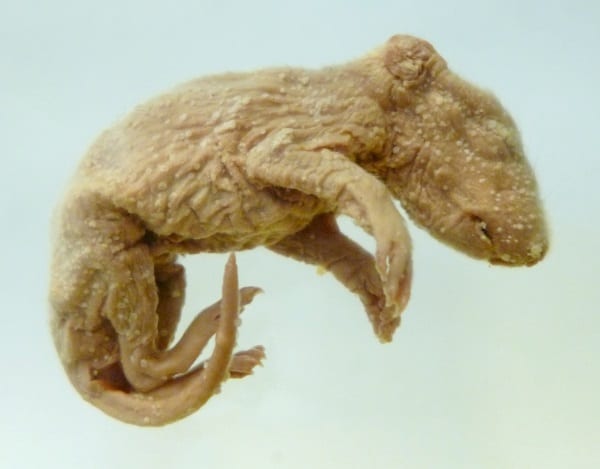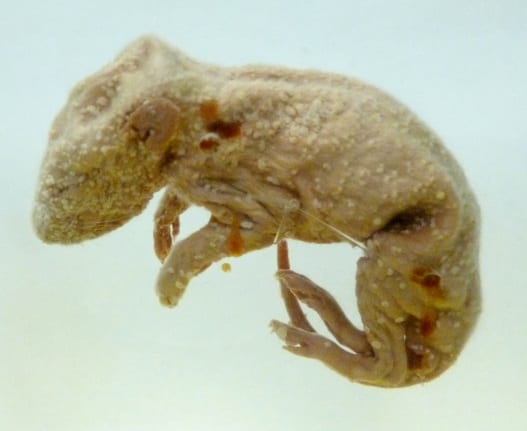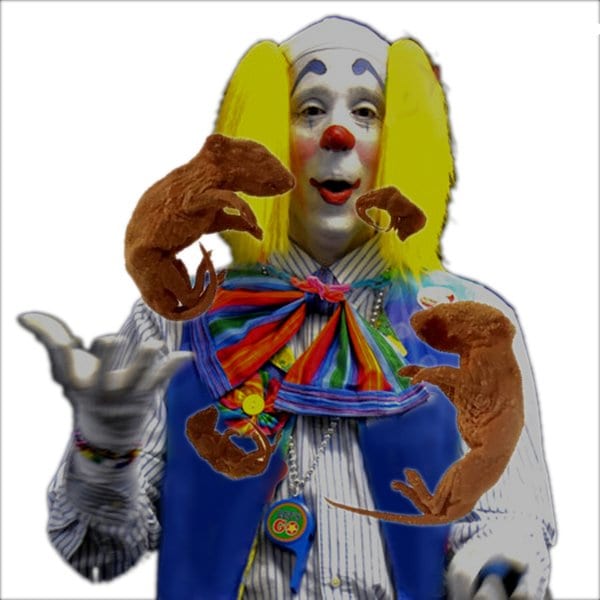Specimen of the Week 226: Preserved neonatal rat group
By Tannis Davidson, on 8 February 2016
Last year, the Grant Museum undertook a major conservation project, Bone Idols: Protecting our iconic skeletons, in which 39 of our rarest and most significant skeletons were cleaned, repaired and remounted.
This year the focus will be on our fluid specimens. The Grant Museum has roughly 6000 preserved specimens is varying states of condition. Over the course of the next 12 months, the most ‘in need’ specimens will be rehydrated, remounted, cleaned and put in new jars (if needed). One of the newly-conserved wetties is a much-improved specimen which has generated quite a buzz around the Museum lately…this week’s Specimen of the Week is…
**The Preserved Neonatal Rat Group**
1. Shriveled sisters
Before December, these little rats were in a terrible state. Situated away from the public eye in the Museum’s wet store room, they were completely dehydrated and knocking about in the bottom of an ill-suited jar. Besides the lack of fluid in the jar, the crystalline residue on the rats was another obvious indicator of concern. Flagged up as ‘Very Poor – complete evaporation of the fluid’ and needing priority care, the rats were packed up and taken to the lab for treatment.
2. Treatment
The first part of their conservation treatment was to soak the rats in a 3% Decon 90 solution on low heat for 2-3 hours. They were then taken off the heat and left overnight. Decon 90 is a surface activated conservation cleaning agent used to rehydrate specimens and soften the brittle tissue.
Next, conservators attempted to manually remove the (still attached) residue from the rats, however these ‘crystals’ would not come off. They are likely a result of a previous unknown chemical treatment and are now permanent.
A vacuum pump desiccator was then used to remove any air bubbles from inside the specimens. After this, they were fixed in formalin (to prevent the tissue from decomposing), washed, and then gradually introduced into higher concentrations of Industrial Methylated Spirit (or IMS, which is ethanol containing a small amount of methanol to make it undrinkable) until the solution reached 80%.
3. A triumph of installation
The crowning glory of this conservation treatment is the inspired positioning of the rats in their new jar. The two smaller prenatal rats were adhered to the backplate using celloidin (an adhesive which does not dissolve in IMS). Their larger neonatal jar-mates were stitched onto the backplate using a nylon filament. Lid on, sealed, all finished. Until the next morning…
4. Dawn of the ooze
In the cold light of the morning-after-the-night-before, a red brown liquid had seeped out of the rat bodies where the two larger specimens had been stitched to the backplate. The fluid in the jar had turned from clear to pale yellow in colour. What was this ooze??
The conservators opined that the rats were possibly initially injected with a substance that was solid in the original formalin solution (the writing on the side of the jar with the crystal residue read “ 50% formalin 1973”) but partially soluble in the current 80% IMS – perhaps a resin or latex. This might explain the chemical reaction crystals on their skin. Or maybe this is a evidence of the reliquification of the internal organs (a result of the specimen rehydration). Or just subcutaneous fat ooze. We just don’t know.
5. The nicknaming of rats
It’s a whimsical reality that specimens in museums often acquire a nickname or two. Some of the most utilised nicknames at the Grant Museum include ‘Elkie’ (the giant deer antlers), ‘half cat’ (the dorsal-ventrally bisected pregnant cat), ‘Rinki’ (the Rhamphorhynchus fossil), ‘Flatypus’ and ‘Platysausage’ (the bad-taxidermied platypuses) and the lord of the balcony ‘Donkel-konkle’ (the otherwise pragmatically-described donkey skeleton).
Now these little rat-a-tat-touilles have ignited a flurry of nicknaming activity around the office. Among the Grant Museum staff the rats have been nicknamed (in no particular order):
– The Gut-Trail Quartet
– The Crystal Sisters
– Wheel of Perpetual Rat
– A Roundel of Rodents
– The Circle of Death
– The Rat Karmic Jar
– Mom, Dad and the Twins
We asked Museum visitors and our friends on Twitter to join in on the fun and suggest nicknames for the rats. Some fabulous responses were submitted but best nickname was the ‘Hanging Clangers’ from @ElizaCorlett. Special mention has to go to @ToneHitchcock for his unforgettable ‘Rat Juggler’, which only makes sense when you see this (slightly terrifying) image…
Tannis Davidson is Curatorial Assistant at the Grant Museum of Zoology
 Close
Close








